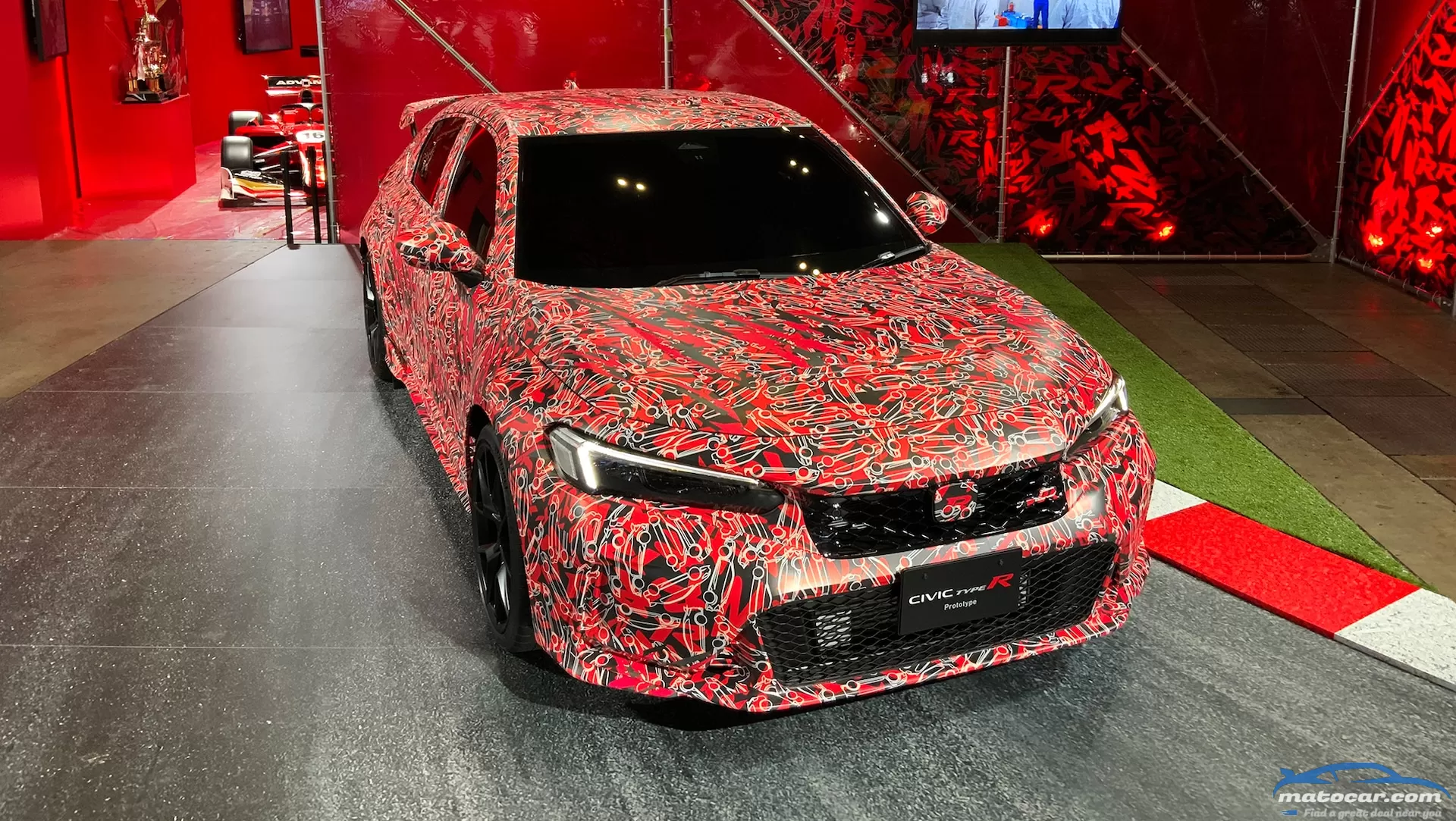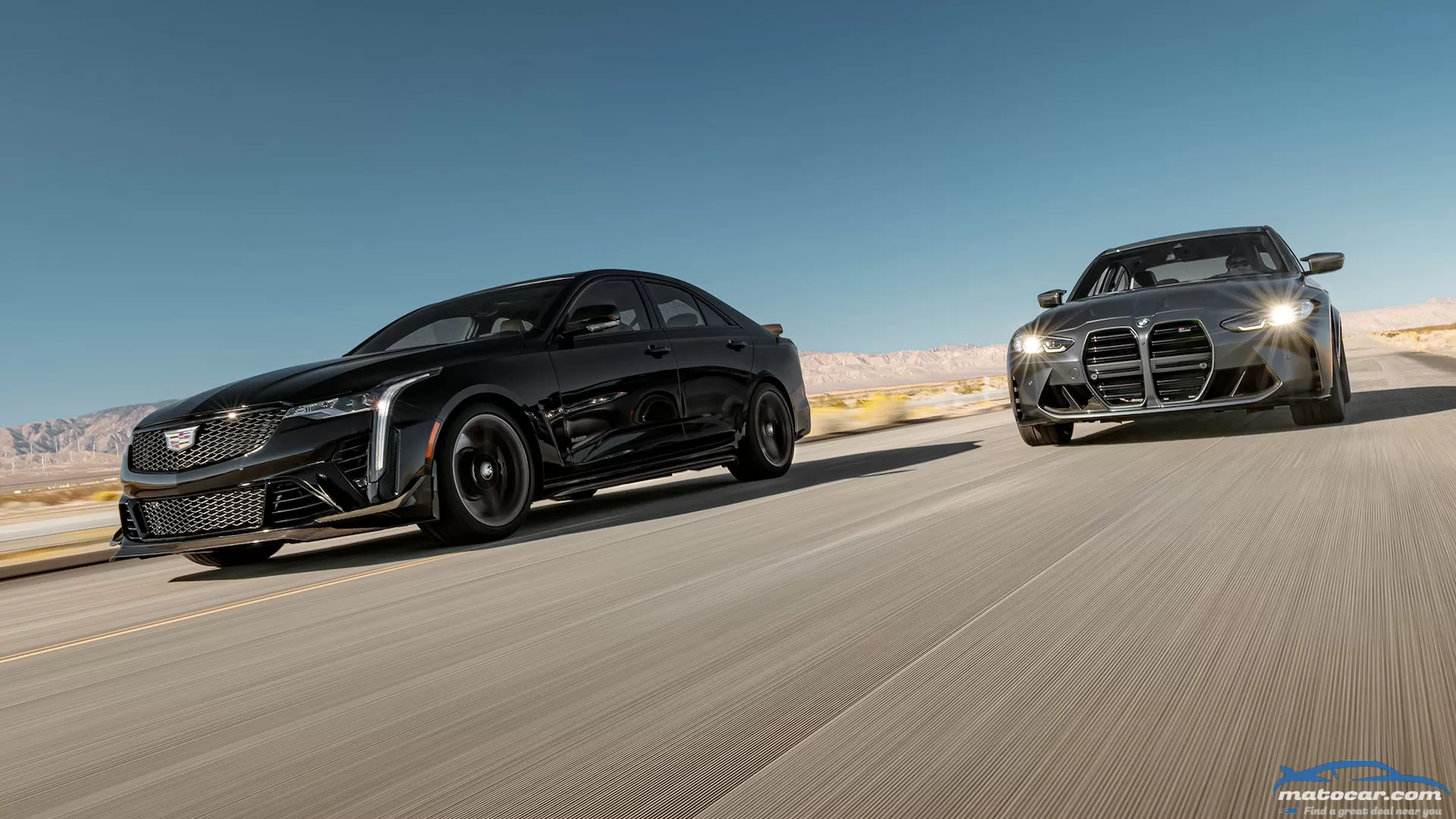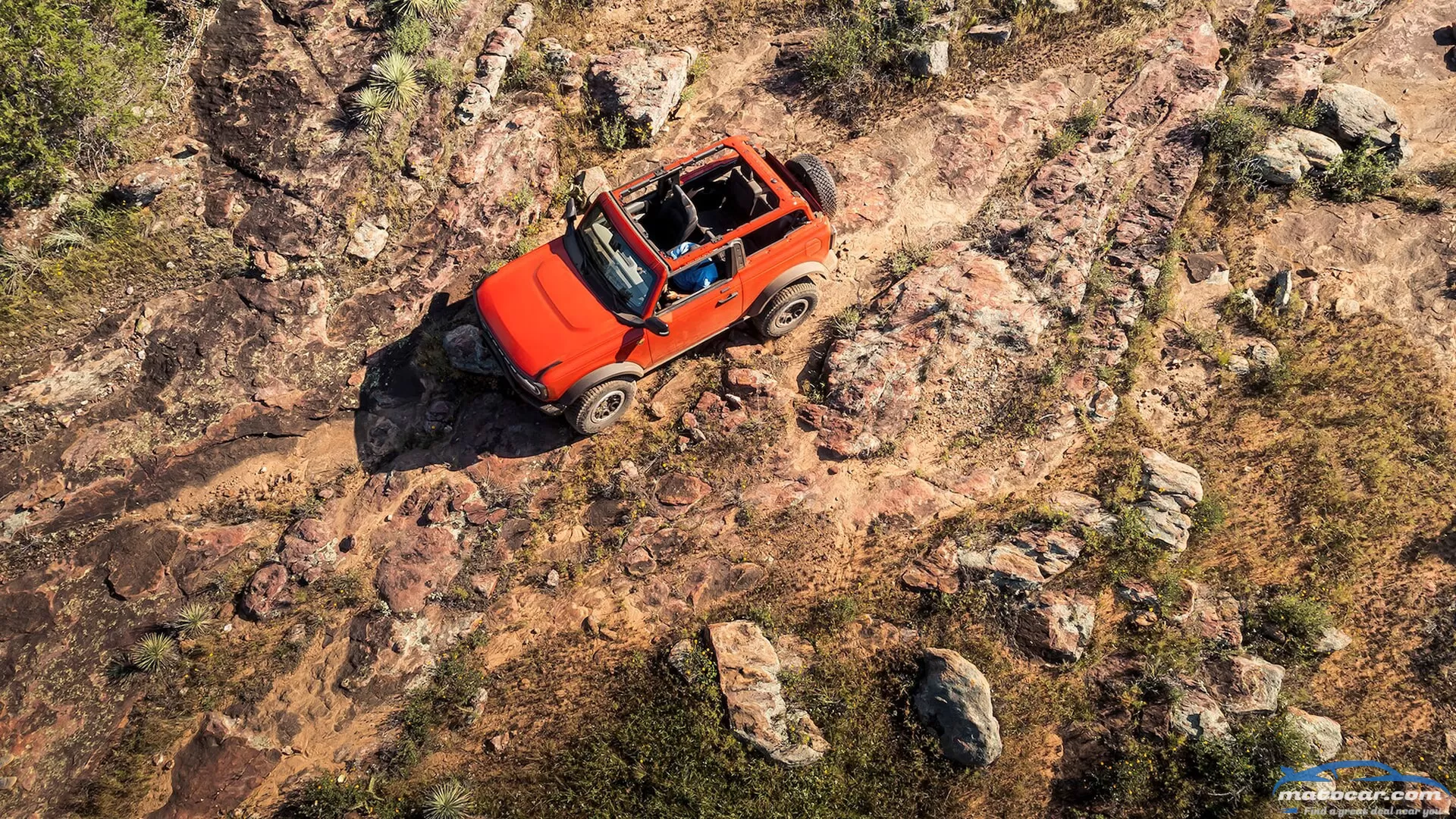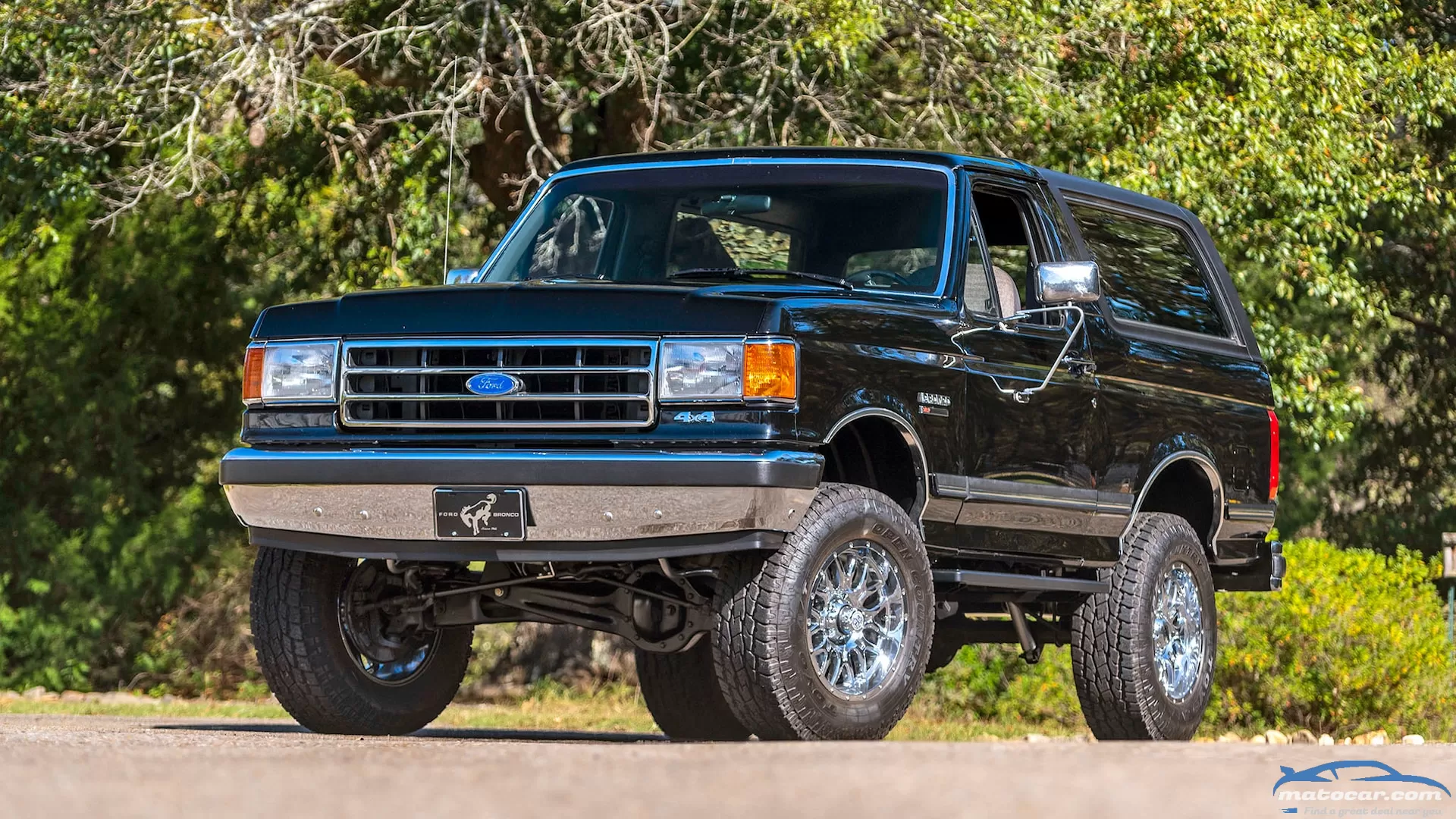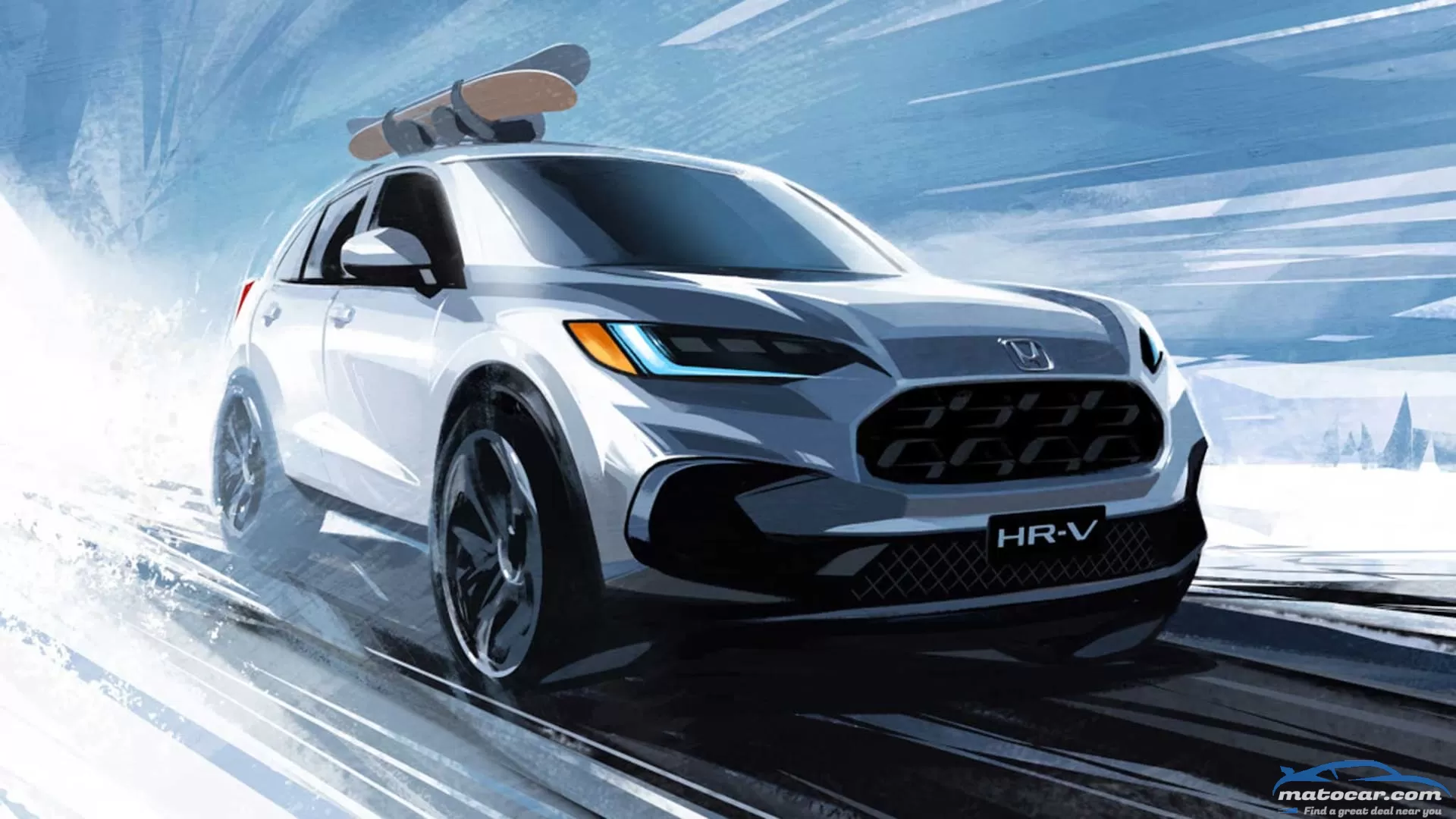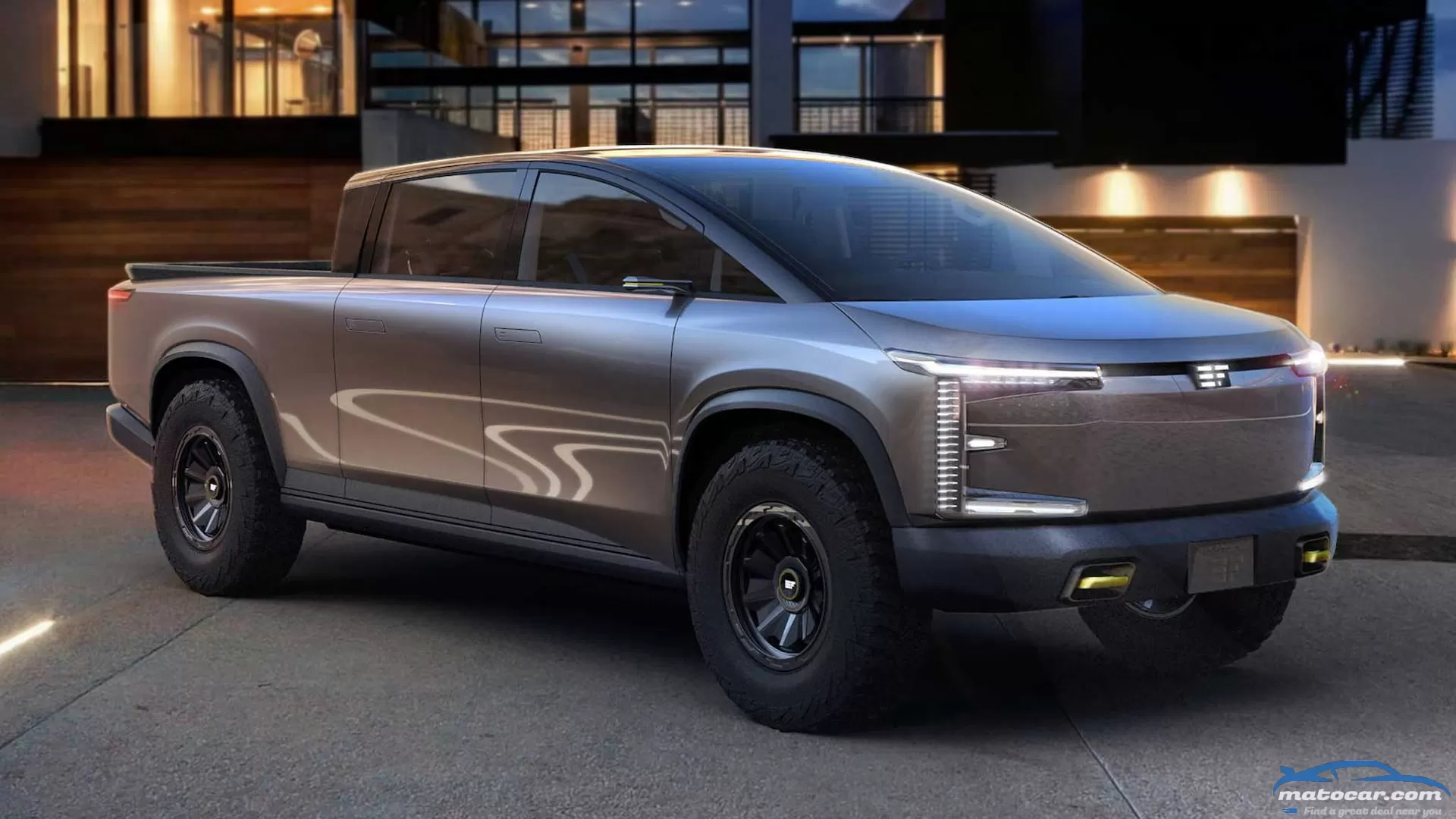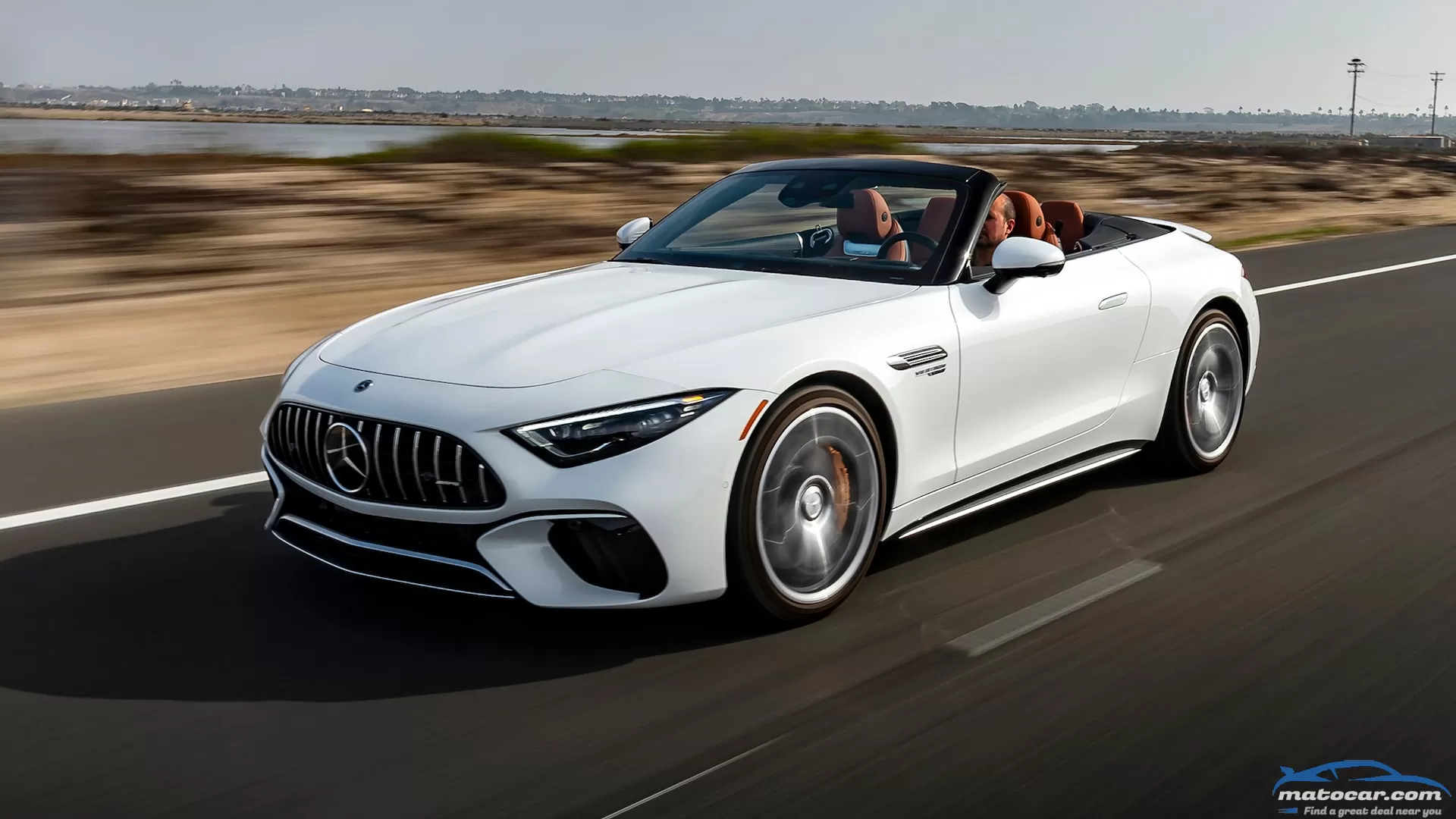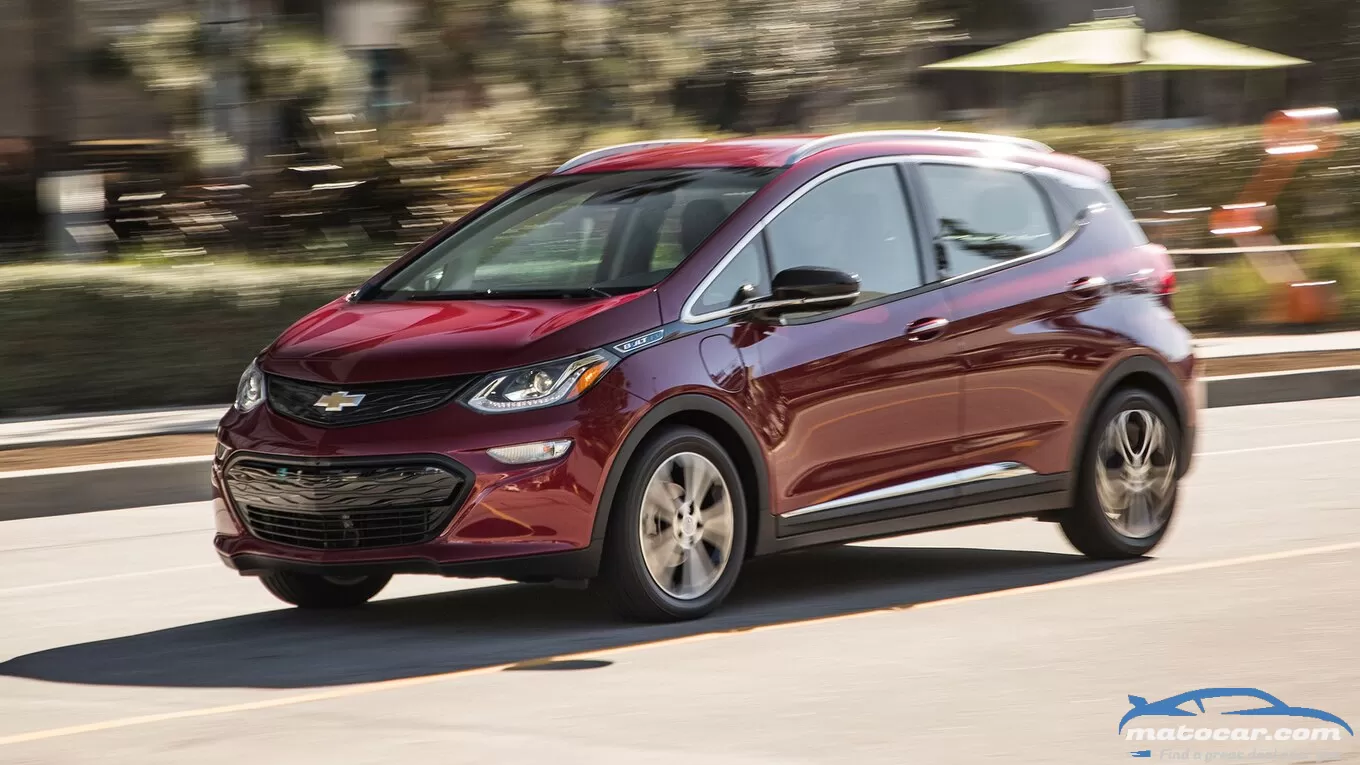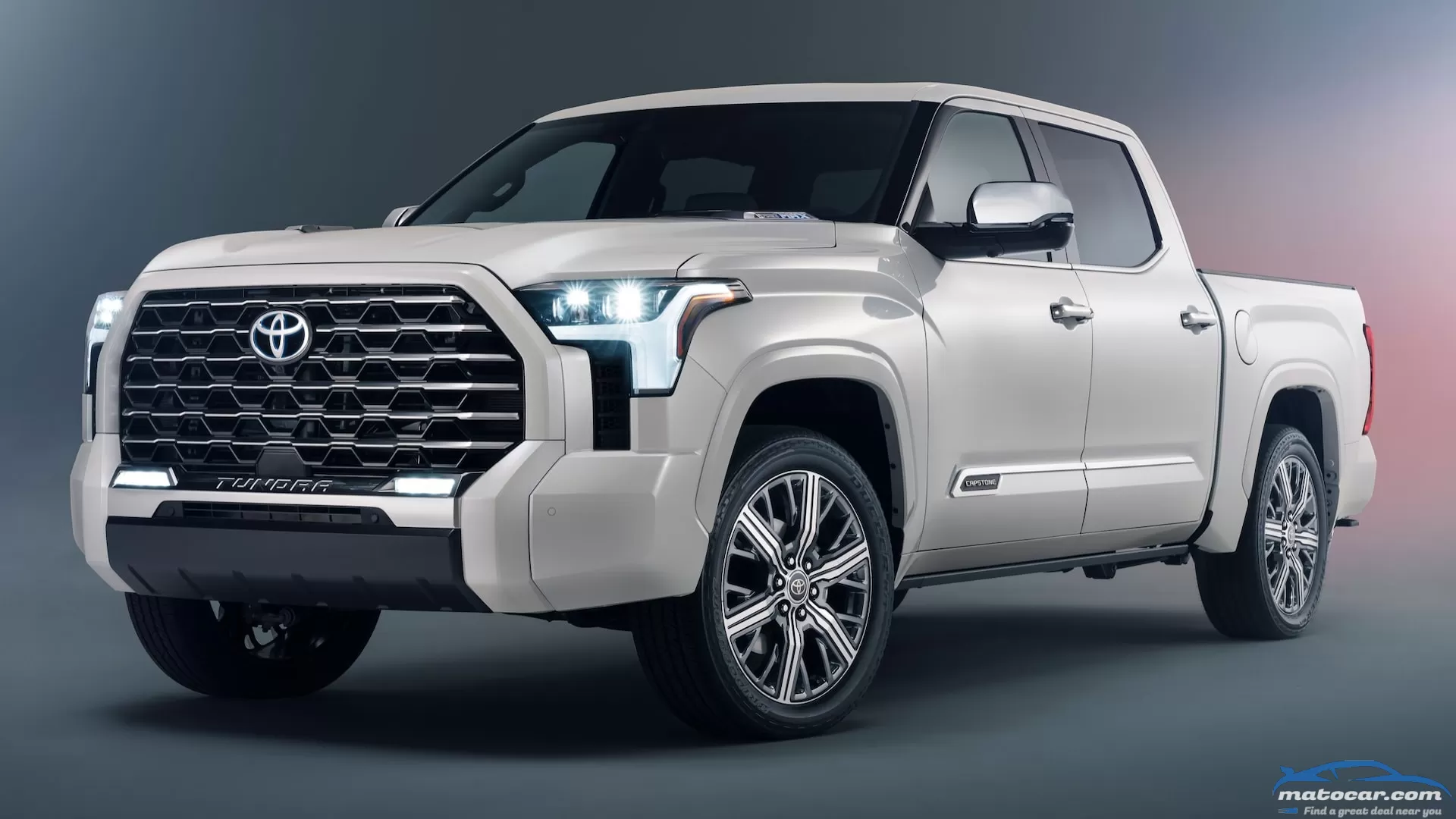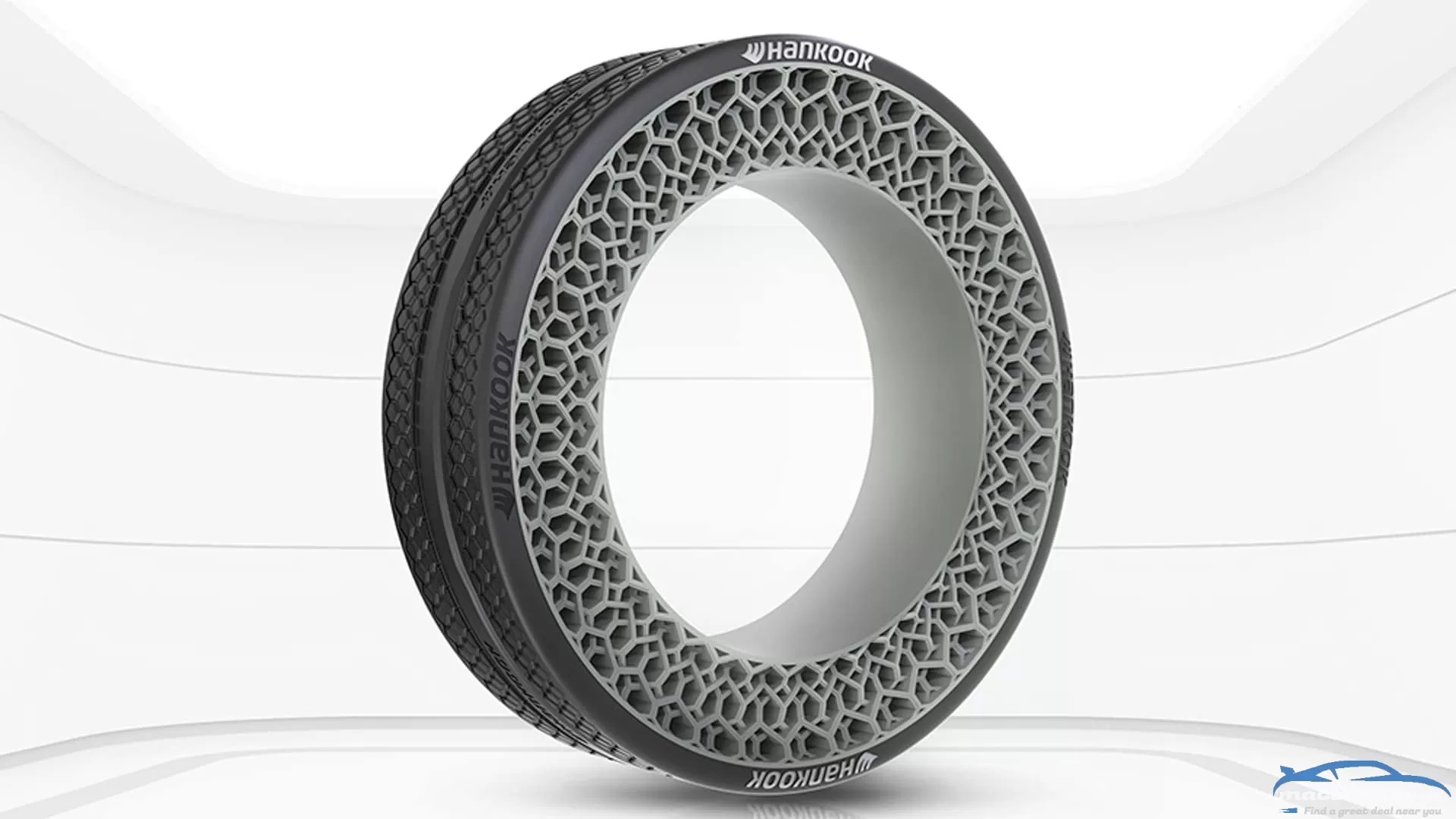The next-generation Honda Civic Type R is on the way. If you've kept up with the latest buzz, then you've seen the red, black. and white camouflaged prototypes several times now. The eagerly awaited hatchback will debut this year as a 2023 model and once again is offered with a manual transmission—an option fast disappearing from the Civic family here in America. But while we continue to wait for the hot hatch's official unveiling, Honda has released footage of the Type R-still under that red, white, and black wrap-zipping through the Suzuka Circuit in Japan. This is essentially video of the same car captured in still photography last month at the same track.When the 2023 Honda Civic Type R finally arrives, it should feature a more powerful 2.0 turbo-four, somewhere in the ballpark of 315 to 335 hp. In keeping with its track duties and sportier appearance, the front-drive hatchback will come fitted with red-painted Brembo brake calipers as the previous model. As for the inside, it appears that Honda is installing an updated version of the cloth bucket seats in the intense Flamin' Hot Cheetos color.The teaser video gives us a sense of the all-new Type R's feral capabilities. Listen to that turbocharged sound—okay, at least in this clip, it doesn't sound like much, but the drone-y engine at least seems quick. We can't wait to try out the grip provided by those sticky Michelin Pilot 4S tires or the pull of that turbo I-4 for ourselves, as we expect the less manic-looking hatchback to push performance limits even harder than the predecessor while upping its already surprising maturity even further.
We're at the end of an era for luxury sport compact sedans. The segment that BMW invented with the 1986 M3 has long embraced change. The little four-cylinder homologation specials that matured the segment beyond icons such as the 2002 eventually became V-8-powered cruise missiles in the early '00s. The engines have since downsized to forced-induction sixes as times changed, and with nearly every automaker now promising to electrify their lineups in the near future, we're witnessing yet another transition. But thanks to cars such as the new 2022 BMW M3 Competition and 2022 Cadillac CT4-V Blackwing, the internal combustion luxury sport compact sedan is going out with a bang.Spec RundownPitting the M3 Competition (the top dog of the M3/M4 lineup) against the CT4-V Blackwing (effectively a reskinned ATS-V) may seem like a mismatch, but there's a method to our madness. The ATS-V, despite never winning a comparison test, had always been one of our favorite vehicles in the segment. The new CT4-V Blackwing, simply put, makes the ATS-V better. Its 3.6-liter twin-turbo V-6 gets a small output boost, now churning out 472 hp and 445 lb-ft of torque, and it's paired with an optional quick-shifting 10-speed automatic (a six-speed manual is standard). It's also crucially fit with the latest generation of MagneRide dampers, and well, that's really about it. Prices start at $59,900, but the CT4-V Blackwing you see here stickers for $80,235.With 473 horsepower and 406 lb-ft of torque spilling forth from its 3.0-liter turbocharged I-6, the standard M3 seems to be an even matchup for the Cadillac. Except when we drove the latest manual-equipped M4 (the two-door version of the M3) back to back with the CT4, it was no competition—the Caddy was just plain better to drive. More fun, more planted, and more capable, it made the M4 feel like a midgrade M440i. So, with an M3 Competition on hand and in the interest of making things, well, interesting, we decided the M3 Competition would take the M4's place.The Competition turns the wick up a bit on the basic M3/M4 formula. Thanks to more boost and upgraded cooling, output rises to 503 hp and 479 lb-ft of twist. To make the most of the newfound power, BMW equips the Competition with an eight-speed automatic, and on our test car, defeatable all-wheel drive (meaning you can force it into a rear-drive-only mode). Prices for the M3 start at $70,895, while the all-wheel-drive M3 Competition xDrive starts at $77,895. A good chunk of our M3 Competition xDrive's $108,545 sticker is eaten up by optional M carbon-ceramic brakes ($8,150) and the dividing (literally) M Carbon bucket seats ($3,800), though the vast majority of the options on our test car are inconsequential cosmetic and luxury options.Hitting the RoadAlthough the outright performance of both the CT4-V Blackwing and M3 Competition is what will get buyers into showrooms, how they drive in the real world is what will sell them. So let's ignore the numbers, shall we? May the most fun-to-drive car win—because after all, "fun" is what this segment is all about.Riding on GM's rear-drive Alpha platform, the Cadillac is, as senior features editor Jonny Lieberman puts it, "a stud." Aided in part by the latest MagneRide dampers and more accessible Performance Traction Management (PTM) modes (now handily operable via a switch on the steering wheel instead of buried in fiddly menus), the CT4-V Blackwing shines on a good back road. Steering is quick and communicative; the chassis feels light, poised, and well balanced; and the car is damn near impossible to upset. The Cadillac's brakes are worthy of praise, too. Despite lacking fancy (read: expensive) carbon-ceramic brake rotors, we are enamored by the steel rotors' stopping power and the CT4's brake tuning. "Makes the M3 Competition feel like it has 320i brakes," features editor Scott Evans said. "Immediate bite, perfect modulation, and it stops so much harder than the BMW."If the Cadillac has a weak spot, its low-revving V-6 is a good candidate. We weren't taken with this engine back when it first appeared under the hood of the ATS-V, and the addition of 8 extra horsepower hasn't made it any better. That's not to say the CT4-V's powertrain is bad. The twin-turbo V-6 is punchy and delivers a broad torque curve, while the 10-speed auto is among GM's best performance automatics yet, with quick, decisive up- and downshifts, and bang-on tuning for hard driving. It's just so … incredibly uninspiring, with a dull, flat exhaust note and a relatively low 6,500-rpm redline. A naturally aspirated V-8—like the one currently available in the CT4's Chevrolet Camaro SS 1LE platform mate—would do much to wake the CT4-V Blackwing up.The M3 Competition, on the other hand, feels as if its "engine runs on Tannerite," as deputy editor Alex Stoklosa puts it. The Bimmer is explosively powerful and gloriously unhinged. Capable of revving to 7,200 rpm, the M3's inline-six feels like a Minuteman missile on a hair trigger, throwing its power down so violently that we question its 503 horsepower rating.But the M3 is more than just an underrated engine. In a welcome change of pace from modern BMWs, steering is quick, and feel is light but direct. The all-wheel-drive system is impressively neutral, too, helping tame the manic engine without negatively impacting steering feel. "The chassis feels very balanced front to rear," Stoklosa said, "and I found it very easy to transition between over/understeer. It's supremely easy and satisfying to meter out just enough throttle to tuck the nose in or kick the M3 into a controllable, easily placed slide."Still, it's not all roses for the BMW. For starters, there are way too many adjustable settings in the M3 and no easy way to cycle through them while on the move; it is much easier to find your Goldilocks setting in the Cadillac. Some editors found the BMW's carbon-ceramic brakes difficult to modulate smoothly when driving hard, though we were all impressed by their stopping power.Do Numbers Even Matter?With any car—but especially performance cars—it's really tempting to get bogged down in the numbers. Surely, they must tell us something, right? Honestly, though, they really don't in this particular case. There will always be cars that are quicker or faster than a BMW M3 Competition and Cadillac CT4-V Blackwing. These cars—among the last of their kind as we approach widespread electrification—are about the way they feel, the way they drive. The emotional response rises above other considerations.You're more than welcome to geek out over performance numbers by scrolling down to the chart at the bottom of the page, but spoiler alert: The more expensive, more powerful, grippier M3 comes out ahead in all of our instrumented tests. But again, in this particular case, so what?Which Car Is Best?When it comes to picking the winner, ignoring everything but the way these vehicles make us feel when unleashed on our favorite roads, the BMW M3 Competition earns the victory. The Cadillac CT4-V Blackwing is a fantastic riding and handling car that's ultimately held back by an uninspiring engine and a general lack of fireworks. The M3 Competition, on the other hand, is everything we're going to miss about internal combustion—loud and unapologetic but also an absolute joy to drive. It's an engaging and organic powder keg and a return to form for BMW. Just a shame about that nose, no?2nd Place: 2022 Cadillac CT4-V BlackwingPros: Well-balanced chassis with great handlingSuperb brakesRelatively cheapCons: Uninspiring engineCould handle more powerBoring exhaust note1st Place: 2022 BMW M3 CompetitionPros: Unhinged engineTransparent all-wheel-drive systemExceptional steeringCons: PriceyCarbon-ceramic brakes aren't worth the upgradeIt's quite rough to look atPOWERTRAIN/CHASSIS 2022 BMW M3 Competition (xDrive) Specifications 2022 Cadilac CT4 V Blackwing Specifications DRIVETRAIN LAYOUT Front-engine, AWD Front-engine, RWD ENGINE TYPE Turbo direct-injected DOHC 24-valve I-6, alum block/head Twin-turbo direct-injected DOHC 24-valve 60-degree V-6, alum block/heads DISPLACEMENT 2,993 cc/182.6 cu in 3,564 cc/217.5 cu in COMPRESSION RATIO 9.3:1 10.2:1 POWER (SAE NET) 503 hp @ 6,250 rpm 472 hp @ 5,750 rpm TORQUE (SAE NET) 479 lb-ft @ 2,750 rpm 445 lb-ft @ 3,500 rpm REDLINE 7,200 rpm 6,500 rpm WEIGHT TO POWER 7.8 lb/hp 8.2 lb/hp TRANSMISSION 8-speed automatic 10-speed automatic AXLE/FINAL-DRIVE RATIO 3.15:1/2.02:1 2.85:1/1.82:1 SUSPENSION, FRONT; REAR Struts, coil springs, adj shocks, anti-roll bar; multilink, coil springs, adj shocks, anti-roll bar Struts, coil springs, adj shocks, anti-roll bar; multilink, coil springs, adj shocks, anti-roll bar STEERING RATIO 15.0:1 11.6-15.5:1 TURNS LOCK-TO-LOCK 2.0 2.2 BRAKES, F; R 15.7-in vented, drilled, carbon-ceramic disc; 15.0-in vented, drilled, carbon-ceramic disc 15.0-in vented disc; 13.4-in vented disc WHEELS, F;R 9.5 x 19-in; 10.5 x 20-in, forged aluminum 9.0 x 18-in; 9.5 x 18-in cast aluminum TIRES, F;R 275/35R19 100Y; 285/30R20 99Y Michelin Pilot Sport 4S 255/35R18 94Y; 275/35R18 99Y Michelin Pilot Sport 4S DIMENSIONS WHEELBASE 112.5 in 109.3 TRACK, F/R 63.7/63.2 in 60.5/60.5 in LENGTH x WIDTH x HEIGHT 189.1 x 74.3 x 56.4 in 187.6 x 71.4 x 56.0 in TURNING CIRCLE 41.4 ft 38.8 ft CURB WEIGHT (DIST F/R) 3,899 lb (54/46%) 3,888 lb (53/47%) SEATING CAPACITY 5 5 HEADROOM, F/R 40.6/37.8 in 38.3/36.5 in LEGROOM, F/R 41.6/35.6 in 42.4/33.4 in SHOULDER ROOM, F/R 56.0/54.6 in 55.2/53.9 in CARGO VOLUME 13.0 cu ft 10.7 cu ft TEST DATA ACCELERATION TO MPH 0-30 1.0 sec 1.5 sec 0-40 1.7 2.2 0-50 2.3 3.0 0-60 3.0 4.0 0-70 3.8 5.1 0-80 4.8 6.4 0-90 5.9 7.7 0-100 7.2 9.4 PASSING, 45-65 MPH 1.5 1.9 QUARTER MILE 11.1 sec @ 124.7 mph 12.4 sec @ 114.0 mph BRAKING, 60-0 MPH 105 ft 106 ft LATERAL ACCELERATION 1.03 g (avg) 1.05 g (avg) MT FIGURE EIGHT 23.3 sec @ 0.89 g (avg) 23.8 sec @ 0.84 g (avg) TOP-GEAR REVS @ 60 MPH 1,500 rpm 1,500 rpm CONSUMER INFO BASE PRICE $77,895 $59,900 PRICE AS TESTED $108,545 $80,235 AIRBAGS 8: Dual front, front side, f/r curtain, front knee 8: Dual front, front side, f/r curtain, front knee BASIC WARRANTY 4 yrs/50,000 miles 4 yrs/50,000 miles POWERTRAIN WARRANTY 4 yrs/50,000 miles 6 yrs/70,000 miles ROADSIDE ASSISTANCE 4 yrs/Unlimited miles 6 yrs/70,000 miles FUEL CAPACITY 15.6 gal 17.4 gal EPA CITY/HWY/COMB ECON 16/22/18 mpg 16/24/19 mpg EPA RANGE (COMB) 281 miles 331 miles RECOMMENDED FUEL Unleaded premium Unleaded premium ON SALE Now Now Show All
porsche taycan Full OverviewLeave it to Porsche. Going into our 2022 SUV of the Year competition, no vehicle had more pre-shade thrown its way than the Taycan 4 Cross Turismo. We've enjoyed a mixed, ambiguous relationship with the Taycan sedan since we first drove it. On the one hand, kudos to Porsche for making a great-handling electric vehicle that emphasizes performance and feel over everything else. On the other, where's the range, bro?Yes, we like performance, but institutionally we just can't fully get behind the industry's least efficient EV. As for the "SUV" version, well, it's just a barely lifted station wagon, right? No different than the crass, "we're not that gullible" efforts from Audi (the A6 Allroad) and Mercedes-Benz (E450 All-Terrain) to pitch station wagons as some sort of off-roaders. But then we made the terrible mistake of actually taking the Cross Turismo in the dirt, and yeah, Porsche strikes again.Before we get to how it drives, let's talk about what the Taycan 4 Cross Turismo is. First off, it's a station wagon by all definitions of the term. Yes, the legal definition of an SUV has something to do with ride height, but as I'm so fond of saying, "Just look at it." Talk about obvious. The Cross Turismo is an incredibly handsome wagon, especially on the tough-looking five-spoke wheels Porsche bolted to our test subject. Tangentially speaking, Taycan wheel design is all over the map, ranging from goofy to horrible to "yeah, baby." These are the latter. Since we drove the Cross Turismo, Porsche went and confusingly launched an uncladded wagon version of the Taycan, the 2022 GTS Sport Turismo, which looks approximately 10 percent better. That's mostly due to the 0.8-inch drop in ride height, meaning the Sport Turismo is technically a car. More on that in a bit.Under the lovely, Chalk-colored metal you'll find two motors: one driving the wheels at the front axle, and the other driving those at the rear. Unlike all other EVs on the market save for its Audi twin, the E-Tron GT, the Taycan has a two-speed transmission that's only connected to the rear motor. As for power, this gets a bit confusing. Combined output from the two motors is 375 horsepower and 368 lb-ft of torque. However, activate launch control, and the two motors go into overboost and the output increases to 469 horsepower, a more than 20 percent increase. Hey, it's a brave, new EV world. The battery pack is large at 93.4 kWh, and the range is EPA-rated at 215 miles. That's down 10 from the mechanically identical Taycan sedan, due a little to the increased weight of the wagon body but more so the increased ride height that also decreases aerodynamic efficiency and forces the halfshafts to sprout from the motor at an angle. Did I mention it weighs 5,134 pounds?The odd part about driving the Taycan 4 Cross Turismo only occurs when you realize there are three more powerful versions available: the 4S, the Turbo, and the Turbo S. There is a non-4, RWD sedan that makes less power (321 hp, 402 in overboost), but this particular version—$92,250 base, $109, 980 as tested—is pretty far down the Taycan lineup, which also includes the GTS sedan and Sport Turismo. Let me also point out that as far as the Taycan—cough—SUVs go, this is the entry-level Cross Turismo. The entry version that can hit 60 mph in 4.5 seconds, of course.The Taycan 4 Cross Turismo can also run the quarter mile in 12.7 seconds at 115.9 mph. That quarter mile is pretty quick, especially for an off-road-capable station wagon. But it's not that quick for an EV, as the Porsche barely edges out the 470-hp Jeep Wrangler 392 that does the quarter in 12.9. Hey we're talking SUVs, right? And remember, that using launch control this Taycan makes precisely 1 fewer horsepower than the double live-axle, brick-shaped Jeep.The Porsche's braking performance is good. Not so much as to stand out, but not bad, and there's nothing wrong with how the pedal feels. It takes 109 feet for the Cross Turismo to stop from 60 mph, 5 feet longer than the much more powerful, capable, expensive Taycan Turbo S with its 17.3-inch front rotors and super-sticky tires. Likewise, the Taycan 4's figure-eight time is good, at 25 seconds flat. I always say any car in the 24-second range is a sports car, and this slightly jacked-up wagon is oh, so close. To give you an idea of how well the Porsche did, remember the Mercedes E450 All-Terrain we discussed earlier? Another gussied-up station wagon pretending to be an SUV? It took 26.2 seconds to get around our figure-eight course. The Audi A6 Allroad? 26.5. Oh, and the Jeep 392? A frankly pathetic 29.3 run, which our test team chalked up to "aggressive ESC."Based on time spent with other Taycans we knew going in that this Porsche would be more fun to drive than the competition on the street. We wrongly assumed that since it's obviously only pretending to be an SUV, it would be weak sauce in dirt. We were totally wrong. Did we attempt any rock crawling? No, and you'd be insane to try. But we did try dirt, sand, and gravel, and, man, was the Cross Turismo not only competent and capable, it was a blast, as well. Especially in sand, where the EV loved kicking up giant rooster tails while simultaneously not even kinda getting stuck. Whatever off-road advantage there is from a 0.8-inch lift, Porsche fully exploited it.Unlike the aforementioned Audi and Mercedes "SUVs," I'd actually recommend the Taycan 4 Cross Turismo as both a driver's car and a light-duty off-roader. It's a genuine double-threat. At this stage in the game do we have the right to be surprised that a Porsche is fun to drive? Naw, probably not. Now, if the fine folks at Zuffenhausen could just do something about the meager driving range.Looks good! More details?2021 Porsche Taycan 4 Cross Turismo BASE PRICE $92,250 PRICE AS TESTED $109,980 VEHICLE LAYOUT Front and rear-motor, AWD, 5-pass, 4-door wagon MOTOR TYPE Permanent-magnet electric POWER (SAE NET) 469 hp TORQUE (SAE NET) 368 lb-ft TRANSMISSION 2-speed automatic CURB WEIGHT (F/R DIST) 5,134 lb (49/51%) WHEELBASE 114.3 in LENGTH x WIDTH x HEIGHT 195.8 x 77.4 x 55.5 in 0-60 MPH 4.5 sec QUARTER MILE 12.7 sec @ 115.9 mph BRAKING, 60-0 MPH 109 ft LATERAL ACCELERATION 0.89 g (avg) MT FIGURE EIGHT 25.0 sec @ 0.76 g (avg) EPA CITY/HWY/COMB FUEL ECON 75/81/77 mpg-e ON SALE Now Show All
A member on the Bronco6G forum noticed something a little funny recently: The 2022 Ford Bronco configurator no longer features the image of the base level Bronco, and the entry-level model is no longer selectable at all. We took a look for ourselves and found that, indeed, the base Broncos are gone and only the price and wording remains above a grayed-out "image missing" graphic. That same Bronco6G forum poster also mentions that a user's local dealer explained their reasoning behind the move.Is There A Replacement?As it seems that Ford has removed the base Bronco from its configurator, we have yet to hear of any official new entry-level trim for the popular SUV. The post was made on January 11, 2022 and the last webpage crawl from the Internet Archive was back on November 19, 2021. We don't know when this was changed and how long it's actually been this way, though if you mess with the Ford website's url to force it to show the 2021 Bronco configurator, the base Bronco tile appears normally and you can build one. It could be that ongoing supply chain issues (and hardtop problems) are impacting the base-level 2022-model-year Bronco, so Ford is putting the kibosh on ordering one (it wouldn't be the first such limit or delay Ford has levied on Bronco intenders).At the time of this writing we have yet to get official word from Ford on the reason the Base model is gone. Either way, the blanked-out base Bronco leaves the two-door Bronco Big Bend version as the new price leader—though for 2022 it starts at $35,280, a far cry from the $30,795 listed for the two-door base version.A Dealer RumorHowever, the rumor mill is picking up where the base Bronco's faint scent trails off. On that same forum post, a member mentions talking to their local dealer about the loss and what was coming. (Again, we have no official word from Ford to verify this and so it should be taken with a grain of salt.) The explanation is that dealers were having trouble with selling the base Bronco for a profit versus other trims and weren't ordering as many.We find that somewhat hard to believe, given the popularity of the Bronco and the stories of people who were willing to fork over cash for one—any Bronco at all, really. Ford does not release monthly sales figures nor do they break down trims in their quarterly figures, so the base Bronco's fate at the hands of dealer ordering preferences or customer preferences are a mystery.A First-Gen Call Back?One interesting theory, on the other hand, was a mention of a "Heritage Edition" to replace the base model. It was described to a forum member as a standard Bronco with a white roof, calling back to the original, first generation Bronco. Given Ford's history of playing up its historic models, we can't say that isn't too far fetched. Again, we must stress that we have reached out to Ford for confirmation on all of this—the loss of the base model and the introduction of a Heritage model—and, as of press time, Ford has not responded to our questions. So don't rush to conclusions until we're able to confirm from Ford any of it is true. If or when we do hear back, we'll update this story.
Related: MotorTrend+ is the exclusive streaming home for Mecum Auctions! Sign up for a free trial today to catch all the action, plus the best automotive shows anywhere!Rare Blend of Power and SUV PerformanceNot Stock but not a Deal-Breaker
We got all excited when Honda introduced the new Euro-market HR-V (known in some parts of the world as the Vezel), but Honda was quick to tell us to calm the hell down—this wasn't the subcompact HR-V we were looking for. The U.S., Honda told us, would be getting a new HR-V all its own. Not to cast aspersions on our friends at Honda, but any time an automaker tells us something like this—any of them, not just Honda—we have to wonder if we aren't just being put off.Today, Honda released sketches of the North American-market 2023 HR-V (actually, they look like paintings, which is rather cool). And no, we weren't being put off—this definitely is a different vehicle. Look at the back doors, and what do you see? Door handles on the body. The new Euro-HR-V/Vezel has its rear door handles concealed in the door pillar, just like the current (and soon-to-be-outgoing) HR-V.From what the paint-sketches show, North America won the HR-V lottery, because if the real thing looks similar, it's going to be a much cuter critter than the HR-V going to Europe. We like the big blacked-out grille—it's rather Kia-esque, from the days when ex-Audi designer Peter Schreyer was trying to make all of his Kias look like Audis. It's certainly a better look than the chromed confusion of the bigger CR-V. (Honda has a new CR-V coming for 2023, and we hope it looks this good.) Speaking of Audis (which we were, weren't we?), the new HR-V's bulbous back end bears quite a resemblance to that of the Audi Q3. We're hoping the swank exterior style is an indicator of what we'll see inside. We rather like the HR-V, and we've always thought a more upscale version would do well with buyers.And what lurks under that handsome skin? Honda's two-sentence statement accompanying the sketches helps little. As a rule we don't copy and paste press releases, but we'll make an exception, given the dearth of other info here: "Honda kicks off its Year of the Crossover with a sneak peek at the all-new sporty and versatile 2023 HR-V. The all-new HRV will launch in North America this year." Okay, so that yields no information. If we had to guess—which, obviously, we do—we'd predict that one of the new HR-V's powertrains will be the 212-hp hybrid powertrain from the Euro-market HR-V, which is based around a 2.0-liter naturally aspirated engine.We assume there will be a non-hybrid version, and as we've complained about the current HR-V's leisurely acceleration, it wouldn't surprise us if its 1.8 liter engine is replaced by something with a little more gumption, perhaps the 2.0-liter naturally-aspirated engine from the entry-level Civic and (if we're lucky) Honda's 1.5-liter turbo, also found in the spectacular new Civic.The fact that the sketches show the HR-V dashing through the snow with snowboards strapped to the roof rack indicates an all-wheel-drive option. That may seem like a no-brainer for an SUV, but remember that some entry-level sport-utes (Toyota CH-R and Nissan Kicks, to name two) don't offer AWD; today's HR-V does offer AWD, however.Whatever the final HR-V looks like and however it's configured, this teaser has done its job: We are genuinely excited to see what the real thing looks like. We don't need to tell you what a hot market segment the compact SUV field is, one chock full of new and credible contenders like the Toyota Corolla Cross, the Kia Seltos, and our pick of the bunch, the Subaru Crosstrek. We're looking forward to seeing how the new 2023 Honda HR-V stacks up.
We're at the end of an era for luxury sport compact sedans. The segment that BMW invented with the 1986 M3 has long embraced change. The little four-cylinder homologation specials that matured the segment beyond icons such as the 2002 eventually became V-8-powered cruise missiles in the early '00s. The engines have since downsized to forced-induction sixes as times changed, and with nearly every automaker now promising to electrify their lineups in the near future, we're witnessing yet another transition. But thanks to cars such as the new 2022 BMW M3 Competition and 2022 Cadillac CT4-V Blackwing, the internal combustion luxury sport compact sedan is going out with a bang.Spec RundownPitting the M3 Competition (the top dog of the M3/M4 lineup) against the CT4-V Blackwing (effectively a reskinned ATS-V) may seem like a mismatch, but there's a method to our madness. The ATS-V, despite never winning a comparison test, had always been one of our favorite vehicles in the segment. The new CT4-V Blackwing, simply put, makes the ATS-V better. Its 3.6-liter twin-turbo V-6 gets a small output boost, now churning out 472 hp and 445 lb-ft of torque, and it's paired with an optional quick-shifting 10-speed automatic (a six-speed manual is standard). It's also crucially fit with the latest generation of MagneRide dampers, and well, that's really about it. Prices start at $59,900, but the CT4-V Blackwing you see here stickers for $80,235.With 473 horsepower and 406 lb-ft of torque spilling forth from its 3.0-liter turbocharged I-6, the standard M3 seems to be an even matchup for the Cadillac. Except when we drove the latest manual-equipped M4 (the two-door version of the M3) back to back with the CT4, it was no competition—the Caddy was just plain better to drive. More fun, more planted, and more capable, it made the M4 feel like a midgrade M440i. So, with an M3 Competition on hand and in the interest of making things, well, interesting, we decided the M3 Competition would take the M4's place.The Competition turns the wick up a bit on the basic M3/M4 formula. Thanks to more boost and upgraded cooling, output rises to 503 hp and 479 lb-ft of twist. To make the most of the newfound power, BMW equips the Competition with an eight-speed automatic, and on our test car, defeatable all-wheel drive (meaning you can force it into a rear-drive-only mode). Prices for the M3 start at $70,895, while the all-wheel-drive M3 Competition xDrive starts at $77,895. A good chunk of our M3 Competition xDrive's $108,545 sticker is eaten up by optional M carbon-ceramic brakes ($8,150) and the dividing (literally) M Carbon bucket seats ($3,800), though the vast majority of the options on our test car are inconsequential cosmetic and luxury options.Hitting the RoadAlthough the outright performance of both the CT4-V Blackwing and M3 Competition is what will get buyers into showrooms, how they drive in the real world is what will sell them. So let's ignore the numbers, shall we? May the most fun-to-drive car win—because after all, "fun" is what this segment is all about.Riding on GM's rear-drive Alpha platform, the Cadillac is, as senior features editor Jonny Lieberman puts it, "a stud." Aided in part by the latest MagneRide dampers and more accessible Performance Traction Management (PTM) modes (now handily operable via a switch on the steering wheel instead of buried in fiddly menus), the CT4-V Blackwing shines on a good back road. Steering is quick and communicative; the chassis feels light, poised, and well balanced; and the car is damn near impossible to upset. The Cadillac's brakes are worthy of praise, too. Despite lacking fancy (read: expensive) carbon-ceramic brake rotors, we are enamored by the steel rotors' stopping power and the CT4's brake tuning. "Makes the M3 Competition feel like it has 320i brakes," features editor Scott Evans said. "Immediate bite, perfect modulation, and it stops so much harder than the BMW."If the Cadillac has a weak spot, its low-revving V-6 is a good candidate. We weren't taken with this engine back when it first appeared under the hood of the ATS-V, and the addition of 8 extra horsepower hasn't made it any better. That's not to say the CT4-V's powertrain is bad. The twin-turbo V-6 is punchy and delivers a broad torque curve, while the 10-speed auto is among GM's best performance automatics yet, with quick, decisive up- and downshifts, and bang-on tuning for hard driving. It's just so … incredibly uninspiring, with a dull, flat exhaust note and a relatively low 6,500-rpm redline. A naturally aspirated V-8—like the one currently available in the CT4's Chevrolet Camaro SS 1LE platform mate—would do much to wake the CT4-V Blackwing up.The M3 Competition, on the other hand, feels as if its "engine runs on Tannerite," as deputy editor Alex Stoklosa puts it. The Bimmer is explosively powerful and gloriously unhinged. Capable of revving to 7,200 rpm, the M3's inline-six feels like a Minuteman missile on a hair trigger, throwing its power down so violently that we question its 503 horsepower rating.But the M3 is more than just an underrated engine. In a welcome change of pace from modern BMWs, steering is quick, and feel is light but direct. The all-wheel-drive system is impressively neutral, too, helping tame the manic engine without negatively impacting steering feel. "The chassis feels very balanced front to rear," Stoklosa said, "and I found it very easy to transition between over/understeer. It's supremely easy and satisfying to meter out just enough throttle to tuck the nose in or kick the M3 into a controllable, easily placed slide."Still, it's not all roses for the BMW. For starters, there are way too many adjustable settings in the M3 and no easy way to cycle through them while on the move; it is much easier to find your Goldilocks setting in the Cadillac. Some editors found the BMW's carbon-ceramic brakes difficult to modulate smoothly when driving hard, though we were all impressed by their stopping power.Do Numbers Even Matter?With any car—but especially performance cars—it's really tempting to get bogged down in the numbers. Surely, they must tell us something, right? Honestly, though, they really don't in this particular case. There will always be cars that are quicker or faster than a BMW M3 Competition and Cadillac CT4-V Blackwing. These cars—among the last of their kind as we approach widespread electrification—are about the way they feel, the way they drive. The emotional response rises above other considerations.You're more than welcome to geek out over performance numbers by scrolling down to the chart at the bottom of the page, but spoiler alert: The more expensive, more powerful, grippier M3 comes out ahead in all of our instrumented tests. But again, in this particular case, so what?Which Car Is Best?When it comes to picking the winner, ignoring everything but the way these vehicles make us feel when unleashed on our favorite roads, the BMW M3 Competition earns the victory. The Cadillac CT4-V Blackwing is a fantastic riding and handling car that's ultimately held back by an uninspiring engine and a general lack of fireworks. The M3 Competition, on the other hand, is everything we're going to miss about internal combustion—loud and unapologetic but also an absolute joy to drive. It's an engaging and organic powder keg and a return to form for BMW. Just a shame about that nose, no?2nd Place: 2022 Cadillac CT4-V BlackwingPros: Well-balanced chassis with great handlingSuperb brakesRelatively cheapCons: Uninspiring engineCould handle more powerBoring exhaust note1st Place: 2022 BMW M3 CompetitionPros: Unhinged engineTransparent all-wheel-drive systemExceptional steeringCons: PriceyCarbon-ceramic brakes aren't worth the upgradeIt's quite rough to look atPOWERTRAIN/CHASSIS 2022 BMW M3 Competition (xDrive) Specifications 2022 Cadilac CT4 V Blackwing Specifications DRIVETRAIN LAYOUT Front-engine, AWD Front-engine, RWD ENGINE TYPE Turbo direct-injected DOHC 24-valve I-6, alum block/head Twin-turbo direct-injected DOHC 24-valve 60-degree V-6, alum block/heads DISPLACEMENT 2,993 cc/182.6 cu in 3,564 cc/217.5 cu in COMPRESSION RATIO 9.3:1 10.2:1 POWER (SAE NET) 503 hp @ 6,250 rpm 472 hp @ 5,750 rpm TORQUE (SAE NET) 479 lb-ft @ 2,750 rpm 445 lb-ft @ 3,500 rpm REDLINE 7,200 rpm 6,500 rpm WEIGHT TO POWER 7.8 lb/hp 8.2 lb/hp TRANSMISSION 8-speed automatic 10-speed automatic AXLE/FINAL-DRIVE RATIO 3.15:1/2.02:1 2.85:1/1.82:1 SUSPENSION, FRONT; REAR Struts, coil springs, adj shocks, anti-roll bar; multilink, coil springs, adj shocks, anti-roll bar Struts, coil springs, adj shocks, anti-roll bar; multilink, coil springs, adj shocks, anti-roll bar STEERING RATIO 15.0:1 11.6-15.5:1 TURNS LOCK-TO-LOCK 2.0 2.2 BRAKES, F; R 15.7-in vented, drilled, carbon-ceramic disc; 15.0-in vented, drilled, carbon-ceramic disc 15.0-in vented disc; 13.4-in vented disc WHEELS, F;R 9.5 x 19-in; 10.5 x 20-in, forged aluminum 9.0 x 18-in; 9.5 x 18-in cast aluminum TIRES, F;R 275/35R19 100Y; 285/30R20 99Y Michelin Pilot Sport 4S 255/35R18 94Y; 275/35R18 99Y Michelin Pilot Sport 4S DIMENSIONS WHEELBASE 112.5 in 109.3 TRACK, F/R 63.7/63.2 in 60.5/60.5 in LENGTH x WIDTH x HEIGHT 189.1 x 74.3 x 56.4 in 187.6 x 71.4 x 56.0 in TURNING CIRCLE 41.4 ft 38.8 ft CURB WEIGHT (DIST F/R) 3,899 lb (54/46%) 3,888 lb (53/47%) SEATING CAPACITY 5 5 HEADROOM, F/R 40.6/37.8 in 38.3/36.5 in LEGROOM, F/R 41.6/35.6 in 42.4/33.4 in SHOULDER ROOM, F/R 56.0/54.6 in 55.2/53.9 in CARGO VOLUME 13.0 cu ft 10.7 cu ft TEST DATA ACCELERATION TO MPH 0-30 1.0 sec 1.5 sec 0-40 1.7 2.2 0-50 2.3 3.0 0-60 3.0 4.0 0-70 3.8 5.1 0-80 4.8 6.4 0-90 5.9 7.7 0-100 7.2 9.4 PASSING, 45-65 MPH 1.5 1.9 QUARTER MILE 11.1 sec @ 124.7 mph 12.4 sec @ 114.0 mph BRAKING, 60-0 MPH 105 ft 106 ft LATERAL ACCELERATION 1.03 g (avg) 1.05 g (avg) MT FIGURE EIGHT 23.3 sec @ 0.89 g (avg) 23.8 sec @ 0.84 g (avg) TOP-GEAR REVS @ 60 MPH 1,500 rpm 1,500 rpm CONSUMER INFO BASE PRICE $77,895 $59,900 PRICE AS TESTED $108,545 $80,235 AIRBAGS 8: Dual front, front side, f/r curtain, front knee 8: Dual front, front side, f/r curtain, front knee BASIC WARRANTY 4 yrs/50,000 miles 4 yrs/50,000 miles POWERTRAIN WARRANTY 4 yrs/50,000 miles 6 yrs/70,000 miles ROADSIDE ASSISTANCE 4 yrs/Unlimited miles 6 yrs/70,000 miles FUEL CAPACITY 15.6 gal 17.4 gal EPA CITY/HWY/COMB ECON 16/22/18 mpg 16/24/19 mpg EPA RANGE (COMB) 281 miles 331 miles RECOMMENDED FUEL Unleaded premium Unleaded premium ON SALE Now Now Show All
EdisonFuture, a California-based startup, is looking to cash in on the e-pickup craze by launching an F-150-sized light-duty full-size electric truck of its own, powered by a range of battery and motor options that includes a 450-mile battery pack and a three-motor configuration good for a reported 700 combined horsepower. Should the legacy and better-established newcomers to this space be worried?What the Heck Is EdisonFuture?This subsidiary of SPI Energy used to be aligned with another spinoff called Phoenix Motorcars. That group made a business of retrofitting Ford medium-duty trucks to electric power.But don't let this fact—and the resemblance of its steel wheels to those of a Ford F-150 XL work truck—lead you to presume this is another modified Ford. EdisonFuture VP of product management Edmund Shen assures us the EF1-T pickup and its van counterpart, the EF1-V are both engineered from scratch by Livermore, California-based EdisonFuture.Ford F-150-Sized, Not F-150-BasedEdisonFuture sees the heart of the e-pickup market as the traditional half-ton size and capacity. So the EF1-T's dimensions and mission don't stray far from the perennial best-selling F-150 and its Lightning electric variant, though it's proportioned more like the forthcoming 2024 Chevrolet Silverado EV—that is, with a shorter "dash to axle" in front, a roomy four-door crew cab, and a 6.5- or 8-foot bed. (Exact body dimensions have yet to be released.)In person, the flat nose and primary headlamp details are more reminiscent of Chevy's electric pickup, while the continuation of the LED lights to form a C-clamp look resembles an F-series Super Duty. Remember, though—it's not a Ford!Three Drive Configurations, Multiple BatteriesEdisonFuture plans to cover the market much like Chevrolet and Hummer EV, with offerings ranging from rear-wheel-drive, single-motor to dual- and tri-motor all-wheel-drive setups. Likewise, there will be a choice of battery pack sizes available to suit various budgets and expectations. To date we only know that the single motor version will accelerate to 60 mph in 6.5 seconds. The two-motor version will produce about 600 hp and be good for 0-60 mph in 4.5 seconds. The three-motor version will produce 700 hp and drop the 60-mph time to 3.9 seconds. EF1-V van models will only offer rear or two-motor all-wheel drive, each of which is rated to hit 60 mph in 6.5 seconds.These will be permanent-magnet motors, and we're told one or more may be clutched, allowing them to idle when not needed during cruising. There's no word yet on battery sizes, but the base truck is said to be good for 300 miles, the two-motor one will go 380 miles, and the top model can cover 450 miles on a charge. A DC fast charge will bring the battery from 0 to 80 percent charge in 25 minutes.Aero Sleek, With an Optional Solar RoofThe "SPI" in the parent company's name stands for Solar Power Innovations, so it should come as no surprise that EdisonFuture will offer a solar roof option on both the truck and van leveraging SPI Energy's latest photovoltaic solar cells. Each will have a similar solar-collecting surface area, and in southern California sunshine we're told it should be capable of adding 15-25 miles of range on a sunny day.The pickup features a three-piece nesting fastback cover that shelters the cargo area, adds to the total solar-cell surface area, and greatly improves aerodynamic drag when fully closed. Rear visibility is provided by camera mirrors, as the cargo cover obscures rear visibility.Three-Seat Front Bench, Two- or Three-Row Van SeatingBoth models displayed at CES 2022—a high-spec pickup and low-spec van—featured a roomy three-seat bench in front. The EF1-V van on display was built for cargo-schlepping fleet duty, showing the lowest of three roof heights. This one is more consumer focused and hence designed to fit comfortably in residential garages, but we're told the highest roof will allow a person to stand in the back (given the height of the floor, that'll be a tall van).Passenger-oriented versions with windows will feature a choice of two or three rows of seating. The van can be configured to carry 260 to 400 cubic feet of cargo and features sliding doors on either side with "barn doors" in the rear.Pickup Cab and Box FeaturesA 17.5-inch floating touchscreen controls all the infotainment features, the long dash surface provides extra solar cells, when so equipped, and the doors can be equipped with removable toolboxes. Side view mirror images are supplied via camera and displayed on dedicated screens located near the A-pillars. A full set of tie-down points is provided in the box, along with what looks like provision for a gooseneck or fifth-wheel trailer hitch.Towing CapacityThe EF1-T Standard model with a single rear motor is rated to tow 7,500 pounds, the EF1-TP premium two-motor variant can do 9,000, and the top EF1-TS Super tri-motor range topper is good for 11,000 pounds. For the EF1-V van, rear-drive models can tow 7,500 pounds, two-motor AWD long-range models are rated for 8,000 pounds.So Should the Others Worry?Competition is competition—unless or until it isn't. Funding could run out, investors may lose their nerve, the executive suite might get raided, or any of a million other potential pitfalls could darken EdisonFuture's, future. But the truck looks intriguing and the initial specs are promising, so we wish the new venture luck.
mercedes-benz sl-class Full OverviewThe AMG gang in Affalterbach desperately wants you to know a few things about the 2022 Mercedes-AMG SL-Class. One, they designed it. From scratch and with little help from the Benz mothership. Two, it barely shares a screw or rivet with the AMG GT Roadster they also designed. Three, despite the new SL having grown a pair of vestigial back seats and adding a few inches in length, it promises to be the sportiest SL roadster since the racing-derived 300SL from 1957. And four, thanks to miracles of modern science, this new R232 SL also promises to deliver comfort on par with—if not exceeding—that of its Mercedes-developed R231 predecessor.Three months of engineering roundtable Zoom calls and even a low-speed ridealong event have sufficiently satisfied us on the first two points; it's the last two that we've been itching to verify. At long last we had the opportunity to flog both the SL55 and SL63 variants on a variety of highways and twisting roads. So, has AMG managed to channel the speed-record-setting, Mille Miglia-winning verve of the original W196 while making the car even more cosseting and comfy than the outgoing roadsters?Mercedes-AMG SL Performance in a Straight LineThe 2022 Mercedes-AMG SL63 will undoubtedly go down in our record books as the quickest SL we've tested. Mercedes claims this 577-hp, 590-lb-ft beast will dash from 0 to 60 mph in just 3.5 seconds, thanks in large part to newly standard all-wheel-drive traction that guarantees none of those ponies or pound-feet gets squandered generating tire smoke or brake heat from traction-control intervention. Converting those estimates to account for MotorTrend launch-control test conditions and a 1-foot rollout will probably boil that number down to something much closer to 3.0 seconds flat. (The last two SL models we tested each beat Mercedes' conservative estimates by exactly half a second.) The SL55, running the exact same engine but with smaller turbos and slightly less aggressive tuning produces "just" 469 horsepower and 517 lb-ft. The AMG team reckons it'll give up three-tenths to the SL63.For some perspective, that performance should rank the SL models somewhere about even with the Porsche 911 Carrera 4S and GTS cabriolets, which is to say, ahead of the BMW M850i xDrive cab (3.9 seconds to 60 mph) and way out in front Lexus LC500 (4.7 seconds) in the bucks-up 2+2 cabrio set.Trust us, if you never drive an SL63, that SL55 will seem like it has more than enough power. However, we might counsel those prepared to settle for the SL55 to consider opting for its AMG Dynamic Plus package, which brings with it a Race mode. We don't typically prefer Race modes because they usually disable all the stability controls, increasing amateurs' risk considerably. This one does not.What it mostly does, in addition to heightening all the car's responses, is switch to a perfectly linear throttle response map. There's more gain earlier in the pedal travel in the Sport and Sport+ modes, which may make the car seem more eager and powerful, but at some cost to the predictability serious drivers prefer. The computer programming in Sport+ and Race modes devotes a bit of extra fuel to generating delightful pops and snorts on overrun. That feature is fun, but this mode also tends to deliver some harsher downshifts when slowing, which can feel like grabbing brakes (this never happened in Comfort mode).We only got the SL63 up to triple-digit speeds briefly, but with the optional AMG Aerodynamics package, an air dam in front of the engine lowers 1.6 inches at speeds above 50 mph to help induce a venturi effect that helps suck the car down to the ground and reduce front-axle lift.SL-Class Handling BehaviorThese are heavy cars, pushing two-and-a-quarter tons. But AMG Active Ride Control, which connects opposite corners of the car hydraulically to limit body roll (as on various McLaren cars and now Rivian trucks), truly makes them feel as agile as cars weighing a half-ton less. This is another feature that's standard on the SL63, and available to help make your SL55 cost almost as much as a 63.Clicking the steering-wheel-mounted drive mode selector clockwise relaxes the stability nannies somewhat, making the cars progressively more neutral in their handling demeanor, but there's no "drift mode," no option to bar torque from reaching the front axle. (That's right—unlike the AMG GT family, the SLs are all-wheel drive.) And hence, even an aggressive drive up Mount Palomar on a cool morning with slightly dewy road surface, we never once sensed Race mode allowing the tail to run wide. More than a little credit here is due the Michelin Pilot Sport 4S tires—265/40 front, 295/35 rear on the standard 20-inch rims, or 275/35 front and 305/30 on the optional 21s we mostly ran.The carbon-composite brakes deserve honorable mention for being equally adept at shedding heroic speeds upon approach to a tightening-radius corner—corner after corner—as they are at executing a limousine stop in town. Both models share this standard six-piston front, single-piston rear brake system.Steering feel changes as you switch modes, and we generally found the comfort mode to be a bit too light. The other modes don't heighten the driver's feel for the road, per se, but the firmer helm feels better. We were blissfully unaware of the four-wheel steering (standard on both models) doing its thing, except when executing exceptionally tight U-turns.The California roads between Newport Beach and Palm Springs are relatively smooth, but we aimed for the bumpiest patches we could find and were impressed by the suspension compliance afforded in Comfort mode. The Sport and Race modes firm things up noticeably enough that we took the time to program the Individual mode with everything set to its raciest option and the suspension set to Comfort. This was our Goldilocks "just right" setting, but we also appreciated that individual characteristics (steering, ride, exhaust noise, etc.) can be easily adjusted on the fly using the round selector and twin toggle switches at the lower left side of the wheel, just opposite the main mode-selector switch. The super-rigid multi-material structure never seemed to twist or jiggle in response to bumps.What's the Mercedes-AMG SL-Class Like to Live With?Mostly wonderful. The cabin seems as quiet with the soft top up as the previous model did with its folding hard top raised. The Z-fold fabric roof lowers in 15 seconds at the touch of a button, and a switch allows all four windows to be lowered simultaneously. Happily, the sun visors swivel out, unlike on some convertibles. Raise the windows and pull up the mesh-screen wind blocker that covers the rear "seat" to keep the cabin remarkably calm and quiet even at highway speeds. In cooler weather, switch on the Airscarf neck-warmer to extend the top-down season (the cockpit isn't long enough to need the E-Class convertible's Air Cap windshield header air-management screen).The center info screen adjusts between 12 and 32 degrees to prevent sun from reflecting directly into the driver's eyes, though the buttons for adjusting this (and for raising and lowering the top) can be hard to see when that glare prompts you to fix the screen. We're also not completely sold on a lot of the capacitive switchgear in use here. The mirror switch, for example, didn't seem to respond as expected. We have yet to experience capacitive switches we love.As with all new Mercedes products, the all-digital instrument cluster can be set to display any of several different themes and tons of information, the most pertinent of which is redundantly shown on the head-up display (standard on 63, optional on 55). Track Pace screens will help folks monitor and improve their performance on their car country club track, and the additional stowage space behind the front seats and in the trunk should make the new SL much more useful as a daily driver.We reckon the new car is comfortable enough to retain the SL faithful and sporty enough to pull some customers out of 911s, the BMW 8 Series, and Lexus LCs. Of those, the BMW's nearly 5 inches of added wheelbase gives it a slightly more usable rear seat (the SL's is only rated for passengers shorter than 5 feet tall). A lighter Porsche will always feel nimbler, and the Lexus design may turn more heads, but this Mercedes-AMG enjoys nearly seven decades of heritage, and this R232 pays legitimate homage to its very best SL progenitors.When and How Much?The 2022 Mercedes-AMG SL-Class will go on sale in the second quarter of 2022. Mercedes isn't talking pricing just yet, but it seems a safe bet to assume that since the new 2+2-seat SL is effectively replacing both the four-seat S-Class cabriolet and two-seat R231 Mercedes-Benz SL-Class, pricing should represent an average of these models. Let's figure $132K for the SL55 and $175K for the SL63. That prices the new SL right in the thick of the 2+2-passenger convertible crowd.Looks good! More details?2022 Mercedes-AMG SL-Class Specifications BASE PRICE $132,000-$175,000 (est) LAYOUT Front-engine, AWD, 2+2-pass, 2-door convertible ENGINE 4.0L/469-577-hp/516-590-lb-ft twin-turbo direct-injected DOHC 32-valve V-8 TRANSMISSION 9-speed auto CURB WEIGHT 4,300-4,400 lb (est) WHEELBASE 106.3 in L x W x H 185.2 x 75.4 x 53.5 in 0-60 MPH 3.5-3.8 sec (mfr est) EPA FUEL ECON 16/21/18 mpg (est) EPA RANGE (COMB) 350 miles (est) ON SALE 2nd Quarter 2022 Show All
New year, new you, and that can also mean a new car. What better way to reset life than updating your means of transportation? This month, automakers are providing significant discounts on leases and a couple electric vehicles to make that leap into a new car a little easier. Customers will also find major savings on an Acura supercar before it rides off into the sunset. These are January's best new car deals.Also check out the best new SUV deals for January.
Can a full-size pickup have too much luxury? If that's the case, we haven't crossed that threshold yet. The combination of high profit potential and flush buyers looking to park a big wad of cash in a do-everything, leather-lined truck means that the freshly redesigned-for-2022 Tundra already has three premium trim levels: Limited, Platinum, and 1794—and that doesn't count the add-on TRD packages for a little extra something something. But the range-topper is all-new, just announced today: Capstone.The 2022 Toyota Tundra Capstone trim will offer a lot of additional amenities if you can stomach a limited menu of configurations. It is only available with the i-Force MAX twin-turbo V-6 hybrid powertrain, with 437 hp and 583 lb-ft of torque, and only in the CrewMax bodystyle with the 5.5-foot bed. A limited menu of colors includes Wind Chill Pearl, Magnetic Gray, Celestial Silver, Midnight Black, Supersonic Red, and Blueprint. Flashy 22-inch wheels are standard—the largest fitted to a Tundra ever, at least by the factory.The Capstone distinguishes itself from lesser Tundras with a unique grille treatment with a body-colored grille frame. Chrome mirror caps echo the chrome treatment of the grille, and those 22-inch wheels have a striking multi-spoke design.Inside, the semi-analine leather seat coverings feature a two-tone black-and-white scheme unique to this trim. Dark walnut open-pore trim is contrasted by the ambient lighting and light-up "CAPSTONE" emblem inside. A panoramic moonroof lets in natural ambient light during the day. Unlike other Tundras, the front door glass has sound-deadening properties for a quieter cabin experience. The cab rides on the hydraulic mounts to reduce cabin NVH, too.Since the 22-inch wheels likely won't help any with ride quality, Toyota offers the optional Adaptive Variable Suspension with rear load-leveling air suspension, which should help in towing and hauling scenarios. Speaking of which, towing capacity doesn't suffer much from the extra glut of equipment; the Capstone can haul 10,340 pounds, which is about midpack in the Tundra i-Force MAX lineup. Payload is 1,485 pounds, which is the lowest rating for any Tundra hybrid, which seems to be the most significant trade-off for selecting the Capstone trim and its many baubles.Like the Tundra TRD Pro, which is also limited to the hybrid drivetrain arrangement, the Capstone is a late-availability trim. It'll show up this Spring. Pricing will be revealed closer to launch, but expect it to keep up with the Ford F-150 Platinum, Ram 1500 Limited, and Chevy Silverado High Country Joneses when it is.
Ever since Michelin revealed the Tweel airless tire in 2004, it has been on the radar for anyone looking to reduce the need for monitoring tire pressures for optimum fuel efficiency and tire safety—at least for applications like ride-on lawnmowers and ATVs. Looks like Hankook is the next to get in on the act with its i-Flex concept that debuted on the Hyundai Plug-n-Drive module concept at CES 2022.What Makes The i-Flex Different?Compared to Michelin X Tweel, the Hankook i-Flex is far more organic in its design—and that's by design. The tire's structure was inspired by "the cellular structure of living organisms." According to Hankook, this allows for "better shock absorption while allowing hexagonal and tetragonal cell structures of different rigidity join together for more stable load support."Made For An Autonomous TableFor now, the tire design is just a concept limited to a 10-inch outer diameter, which was perfect for the Hyundai Plug-n-Drive (PnD) module that also debuted at CES. You can almost think of it as a rolling, self-driven table. "The PnD modular platform is an all-in-one mobility solution that combines intelligent steering, braking, in-wheel electric drive and suspension hardware. The single wheel unit uses a steering actuator for infinite wheel rotation." In other words, it can turn around itself like that Lazy Susan on your table—except it's the whole table and it can drive around. With LiDAR and camera sensors, a PnD-enabled object can move autonomously, and the PnD modules can be attached to virtually anything that needs additional mobility.When's It Coming?The i-Flex has been in the works from Hankook since 2010, but a production version still isn't in sight. There are no explicit plans for building something larger than these small concept tires, but we have to imagine that Hankook is considering scaling up the concept for cars. We just don't know how far in the future that'll be.

